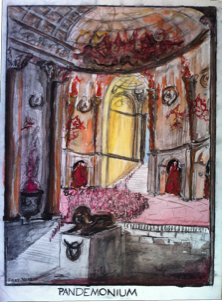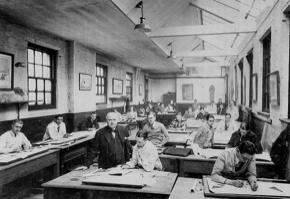Spring 2021: The 43 drawings: Upon Colin Rowe's death the giant portfolio of what remained of his schoolwork from the University of Liverpool left Ithaca, NY and returned to England with a small group of the drawings left behind with me in New York. In 2021 I broached the subject to the Rowe family: “what to do with the drawings?” and how and where they should be reunited and preserved, and ultimately made available for research and review. After much consideration, it was agreed that the drawings would be offered to Yale University where, in fact, in 1951 Colin had been awarded a Smith-Mundt/Fulbright scholarship for study in the US to work with Henry-Russell Hitchcock. Hitchcock raised his interest in the routes by which modernism had developed out of nineteenth-century architecture. Thus, his first encounters in the US were at Yale, after receiving his Master’s at the Warburg Institute, under the tutelage of Rudolf Wittkower.
The first Step, 2021: It was left to me to craft a proposal to send to Yale with a sampling from the portfolio of drawings. Thanks to the assistance of Deborah Berke, Dean of the School of Architecture at Yale, the proposal was forwarded to Yale University Library and upon review the drawings were accepted by the Arts Library Special Collections in 2022.
In the winter and spring of 2023 the archivist retrieved the drawings from England and New York and they were finally reunited, and became the property of the Yale University Library in the Fall of 2023. The drawings are in the process of being cataloged and conserved, and therefore, they are not available at this time for review or research purposes. Once the process of cataloging and conservation is complete, there will be an exhibition of the collection at the A & A Gallery in the School of Architecture at Yale with a date yet to be determined. Close Reads Consultancy will participate in the curatorial process.
The Drawings include classroom assignments in watercolor and collages of interiors as well as studio design projects rendered on both paper and vellum. The earliest drawing in the portfolio is a watercolor signed and dated 1938 with first year design written across the bottom. The portfolio also includes a series of rather fantastical, large watercolors with the titles, Banqueting Hall, Pandemonium (here illustrated) and Palace for the God Kings (also illustrated). These watercolors are all dated 1939 which would mean they were produced at the end of his first year or during his second year.
New and Ongoing Ventures—2024
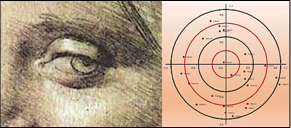
What is Meant by 'The Art of Looking?'
.....One moment is enough if the concentration is absolute.
Bernard Berenson
Towards an Exhibition

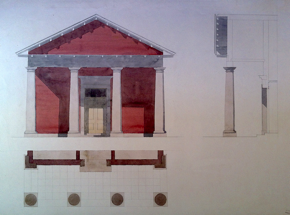
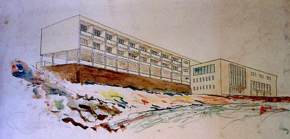
Pandemonium, watercolor on paper,
25 1/2" X 35"
Palace for the God Kings, watercolor on paper, 27 1/2" X 40"

Most of the other drawings are from 1940/1941 and 1943/45 and almost always with C F Rowe written in the bottom right. When the letter ‘C’ appears in a circle, the ‘C’ signifies ‘Completed.' In 1942 Rowe was called up for military service and did not return to Liverpool until 1943 after a lengthy recuperation period from an injury he sustained while training with the Royal Air Force. Therefore, there is a gap in his education until he returns to complete his studies and thesis in 1945.
The collection of drawings is enlightening in their own right, certainly, but they, it seems to me, go beyond merely the fulfillment of classroom and studio assignments. The 'fantasy' drawing, Pandemonium of 1939 is not only highly amusing in its own right, but when one realizes on a close read that the giant niche's half dome is illuminated by a raging fire, it becomes an oblique, aesthetic critique of the previous decades. On the other hand, a second 'fantasy' The Palace of the God Kings moves into an orbit of abstraction where fields of color and cubic forms prevail, no doubt, a hint at Rowe's own proclivities and the draw of Modernism.
A watercolor of a Classical Temple (illustrated), dutifully drawn, is pushed aside by a watercolor of what appears to be a Brick Building (illustrated), with strip windows, columns, recessed balconies, and a flat roof with what appears to be a perforated overhang. It appears, also, that the Classical Temple is passed over by Building in White (illustrated) viewed though unadorned, modernist columns. For this synopsis I have chosen to place the design of his Airways Hotel (illustrated), not dated, next to his earliest watercolor assignment I identify as a Villa, from 1938 (mentioned above), which, to me, has overtones of Asplund’s Villa Snellman. These renderings both give clues, even then, to his fascination with paradoxes, obliquity and his need to ferret out and understand the Modern Movement. The plans and diagrams for the Airways Hotel, although not illustrated here, also disclose his exploration into the significance and meaning of the free plan and form-making.
At Yale, Rowe will be in the company of other esteemed architects, historians and critics, among them: Louis Kahn; Carroll L V Meeks; Paul Rudolph, Eero Saarinen; and Vincent J Scully, to name a few.
School of Architecture, Ashton Street: interior of studio, 1930, archival photo
University Archives, University of Liverpool
Click photo to see full-size
Study of a Classical Temple, early assignment, watercolor on paper
Modernist apartment block, watercolor on paper,
25" X 39"
Modernist building facing a courtyard, watercolor on paper, 27 1/2" X 31"
Villa, 1938, first year, watercolor on paper,
30" X 22"
Airways Hotel, watercolor on paper,
27 1/2" X 15" cropped
All watercolors:
© Yale University Arts Library Special Collections
Gift of the Rowe family and Judy DiMaio
Photographed by the author
Click image to see full-size
Click image to see full-size
The Drawings of Colin Rowe, the Liverpool Years,
1938–1945
